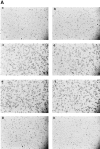Heterogeneity among Ly-49C natural killer (NK) cells: characterization of highly related receptors with differing functions and expression patterns
- PMID: 8976165
- PMCID: PMC2196378
- DOI: 10.1084/jem.184.6.2085
Heterogeneity among Ly-49C natural killer (NK) cells: characterization of highly related receptors with differing functions and expression patterns
Abstract
Ly-49C is a member of the polymorphic family of murine NK cell inhibitory receptors. The 5E6 antibody that defines a subset of NK cells responsible for the rejection of parental H-2d bone marrow by F1 mice has been shown previously to react with Ly-49C. Here, the 5E6 antibody was found to detect two Ly-49C-related molecules in B6 mice. Two cDNA clones were isolated from B6 NK cells, one identical to previously reported Ly-49CB6 and the other a novel cDNA. The deduced amino acid sequence of the latter differs from that of Ly-49CBALB at only 4 residues, whereas the previously reported Ly-49CB6 differs at 22 residues. Flow cytometric analyses of COS cells transfected with the two cDNAs showed that the 5E6 antibody binds to both Ly-49 molecules, while another anti-Ly-49C antibody, 4LO3311, binds to the newly described Ly-49C but not the previously reported Ly-49CB6. Two-color flow cytometric analysis detected 5E6+4LO3311- as well as 5E6+4LO3311+ subsets of NK cells from B6, but not BALB/c, mice. The level of Ly-49C expression on B6 NK cells detected by the 4LO3311 antibody was substantially lower than that on BALB/c NK cells. Binding specificity of the novel Ly-49CB6 was indistinguishable from that of Ly-49CBALB, whereas no binding was detectable with previously reported Ly-49CB6. These results demonstrate that the newly described Ly-49CB6, not the previously reported Ly-49CB6, is the probable B6 allelic form of Ly-49C. The previously reported Ly-49CB6 must be encoded by a separate gene and should be renamed Ly-49I. The implication of these results with respect to the role of Ly-49C in hybrid resistance is discussed.
Figures






References
-
- Wong S, Freeman JD, Kelleher C, Mager D, Takei F. Ly-49 multigene family: new members of a superfamily of type II membrane proteins with lectin-like domains. J Immunol. 1991;147:1417–1423. - PubMed
-
- Yu YYL, George T, Dorfman JR, Roland J, Kumar V, Bennett M. The role of Ly-49A and 5E6 (Ly49C) molecules in hybrid resistance mediated by murine natural killer cells against normal T cell blasts. Immunity. 1996;4:67–76. - PubMed
Publication types
MeSH terms
Substances
Associated data
- Actions
LinkOut - more resources
Full Text Sources
Molecular Biology Databases

